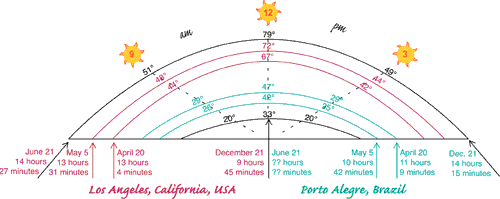|
We’re looking at the question, "why are the days getting longer?"
Remember! This is a reprint of an article that originally appeared in the LA Times on May 20, 1999. That means the days were getting longer as summer approached. Now summer is over and winter is approaching. Have you noticed how the length of day has been changing?
Our recent experiments have focused on the path taken by the Sun
across the sky in Los Angeles. We have discovered, from using our
celestial spheres, that the day's length is directly related to the
length of the Sun's arc on that day. So we might come up with a
general rule: the longer the arc, the longer the day; the shorter
the arc, the shorter the day.
Two weeks ago, we asked you to ask your
relatives in other parts of the world to take Sun measurements so
that we could compare them to the Sun's arc in Los Angeles.
Thanks to everyone that sent data in. One particularly interesting
set of data came from Ana Tereza, Paulo and Luiz Alberto Livi in
Porto Alegre, Brazil. This city is almost exactly as far south of
the equator as Los Angeles is north of it (Los Angeles is at 35°
north latitude, Porto Alegre is at 32° south latitude). In this
week's graph, we compare the data from Brazil with the data from
Los Angeles.

As you can see, the arc of the Sun is much shorter
in southern Brazil than in Los Angeles, and the day is much shorter,
too. So our general rule seems to apply. Further, if you compare the
length of the day on May 5th in Porto Alegre, the day is shorter than
it was on April 20th. As you know, the reverse is the case in Los
Angeles. So, while the days are getting longer north of the equator
(in Los Angeles), they are getting shorter south of the equator
(in Porto Alegre). What would you guess will happen on the solstice
(June 21st) in Brazil? Post your answer at the Sun Spot Bulletin Boards.
If you get it right, you'll get a special Sun Spot prize.
 |
Another thing to notice when we compare this
data is that the Sun's arc in Brazil is actually on the opposite side of
the celestial sphere. In other words, Brazilians are currently seeing
the Sun in the northern part of their sky while we see the Sun in the
southern part of our sky. So everything seems to be reversed in Brazil.
(I wonder if my Aunt Tilty has ever visited there?) And guess what?
Right now it’s late Spring in Los Angeles, while in Brazil it is
late Fall! And the hottest month of the year in Brazil is actually
January!
|
Next week, we will finally start to figure out what
is going on!
|